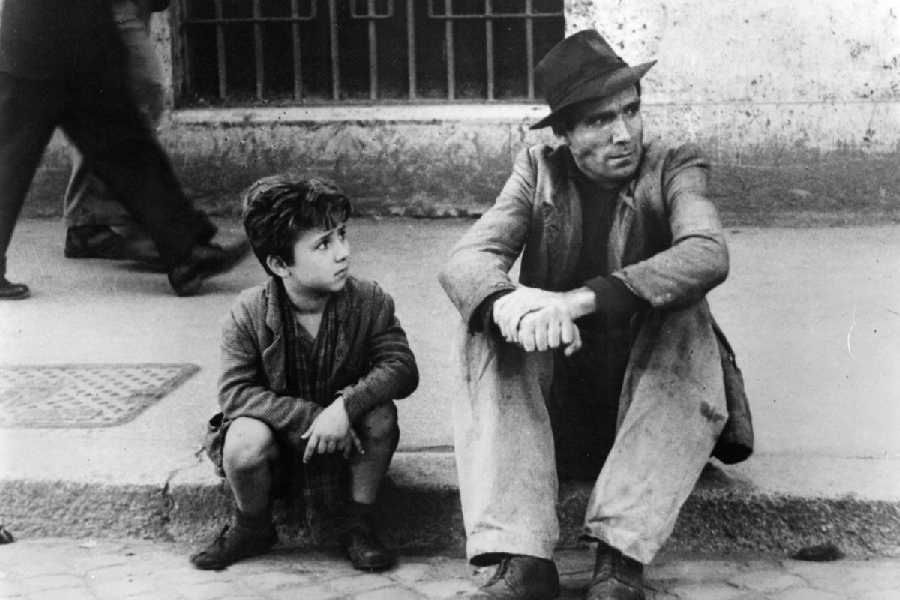When it was released in 1948, Ladri di Biciclette or Bicycle Thieves challenged everything that came before it. So compelling was Vittorio De Sica’s craft that it shook the cinematic landscape.
It’s of little surprise then it still makes audiences come alive with its powerful statement, and at the same time, giddy with its reserve of warmth and beauty.
Thanks to Cine Central, this masterpiece of Italian neorealism was screened at the Rammohun Library Hall in Calcutta recently, at an event to commemorate its turning diamond. That evening as the curtains rose, a hush fell. It was resounding, and reverential. It is uncanny how some films grip you, and we flock to them to be gripped over and over again.
But why must we still care about Bicycle Thieves? Part of the answer lies in the context. Neorealism took shape when some filmmakers in Italy started rejecting the prevalent star and studio-based filmmaking for honest portrayals of life, the struggles of the working class, especially in the aftermath of Benito Mussolini’s rule and WW II. It grew into a national movement, shining light on a radically new technique and content devoid of artificiality, speculative or supernatural elements. Also, the space was jaded with Hollywood remakes, which were of no relevance to the public, and Mussolini’s milking of the visual medium — his thriving industry produced slick melodramas, high-society romances and propaganda. In fact, De Sica was an actor here before he became maker.
It must also be remembered how the cast of Bicycle Thieves was chosen. Almost everyone in it was a non-professional actor. This was part of the great neorealism dialogue — minimal “acting” for maximum authenticity.
So Lamberto Maggiorani, who plays Antonio Ricci, was actually a factory worker. Of course, he went on to star in other films but those roles never matched the success of his first. Lianella Carell, who plays Antonio’s wife, was a journalist who had come to interview De Sica. While little Bruno was spotted in nine-year-old Enzo Staiola, who it is said was peeping from a gathered crowd.
For us Indians specifically, the proceeds are more tangible. If it weren’t for Bicycle Thieves, Pather Panchali perhaps would not have come into being. “If my mind was looking for a sanction for everything radical that I had wanted to do if I ever made a film, I had found it in that one film by De Sica. I stayed in the continent for one more month... It was on this voyage back home that I wrote the first draft of Pather Panchali,” wrote Satyajit Ray in 1950.
Cut to Bicycle Thieves. The film has no great story or plot — the camera simply shows the events of one day. The desperation of Ricci as he, with his son Bruno, searches for his stolen bicycle through Rome’s rough quarters. The bicycle is the man’s sole link to a job — of pasting Hollywood posters on walls. The means was made possible only the previous day, when Maria conjured up the money by pawning some bed linens she had brought as her wedding trousseau.
Frame after frame, father and son move through marketplaces selling stolen goods, through rain and indifferent streets, church and brothel, the futility of it all making a thief out of an honest man. A broken Antonio, following a spot of anguished indecision, tries to steal a bike he finds unattended. The narrative ends in a father’s deep humiliation before his son.
And yet, all of this doesn’t pull you down. Throughout the 1.5-hour black-and-white film, the buoyancy is impossible to not feel. In moving through everyday locations and nondescript quarters, De Sica’s camera achieves what no human eye can. The harmony of pace, angles, length of shots, background score, not to forget the impish Bruno’s endearing expressions...
At the Rammohun Library Hall, the initial silence soon gave way to murmurs of protests. The English subtitles were not keeping pace with the dialogues. It was like pin-prick to the sensibilities of De Sica acolytes. But then, such is the devotion that the visual-verbal disharmony notwithstanding, by the end of the show the atmosphere was soused and palpable.
Just like a love anniversary.










